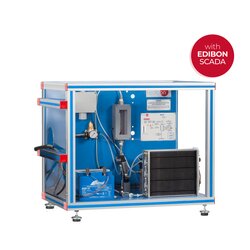Computer controlled wind power plants application with induction generator (AEL-WPPIC)



PL-640396
The Computer Controlled Wind Power Plants Application with Induction Generator, “AEL-WPPIC”, developed by EDIBON, is designed for the study of the characteristics and behavior of induction generators used in wind turbines that inject power into the grid. The application provides users with the opportunity to explore the electrical schemes and operational features of wind turbines that utilize three-phase squirrel cage rotor generators in wind power plants.
The AEL-WPPIC application includes a squirrel cage induction generator coupled to a three-phase motor (turbine), with the motor’s speed regulated via a variable frequency drive. The system simulates various wind conditions and the drive train of a wind turbine. The unit also incorporates a turbine controller that automatically controls the electrical parameters and speed of the turbine-generator group, in addition to performing the automatic synchronization of the three-phase induction generator with the grid.
This control module also serves as an advanced protection system for both the generator and the turbine, meeting ANSI protection standards (ANSI 81O, ANSI 81U, ANSI 59, ANSI 27, ANSI 50/51, ANSI 32R/F, ANSI IOP 32, ANSI MOP 32, ANSI 46, voltage asymmetry, generator ground fault, phase rotation, and generator lagging power factor, among others). Additionally, a three-phase capacitors bank is included to generate the necessary reactive energy to prevent the induction generator from consuming it from the grid. A network analyzer monitors the generation’s electrical parameters.
The core of this application is the wind power plant simulation software, “PSV-WPPP-SOF”. This software allows users to remotely control and automatically synchronize the turbine-generator group, while monitoring various generator electrical parameters, energy losses, and voltage drops. It also enables users to save and compare data for later analysis. The software provides accurate insights into the effects of reactive power compensation, energy demand, load unbalances, and the power factor variation.
Moreover, the PSV-WPPP-SOF software offers the capability to simulate pre-configured wind curves for real-time or later analysis of the induction generator's response. Users can examine the speed and power curves of the simulated wind turbine based on pre-configured values, facilitating a comprehensive study of wind power plants.
For additional learning, it is recommended to acquire modules for the study of island operation of the three-phase induction generator, along with manual compensation of reactive power. The analog instrumentation module for measuring key electrical parameters (P, Q, V, f) of the generator is also recommended to enhance the study.
AEL-WPPIC
- AEL-WPPIC. Application:
- N-ALI01. Industrial Main Power Supply Module.
- N-ERP-PGC02. Turbine Protection and Control Module.
- N-EALD. Electrical Network Analyzer Module with Oscilloscope and Data Acquisition.
- PSV-WPPP-SOF. Wind Powered Power Plant Simulator.
- N-CAR19T/3C. 3 x 300 Var Three-Phase Configurable Capacitors Module.
- GMG1.25K3PH. 1.25 kW Generator-Motor Group.
Required elements (Not included):
- AEL-PC. Touch Screen and Computer.
Additional recommended elements (Not included):
- N-REVT/1K. 1kW Three-Phase Resistors Module.
- N-INDT/3C. 3 x 300 Var Three-Phase Configurable Inductances Module.
- N-PPIM1. Instrumentation Module 1.
The complete unit includes as well:
- Advanced Real-Time SCADA.
- Open Control + Multicontrol + Real-Time Control.
- Specialized EDIBON Control Software based on LabVIEW.
- National Instruments Data Acquisition board.
- Calibration exercises, which are included, teach the user how to calibrate a sensor and the importance of checking the accuracy of the sensors before taking measurements.
- Projector and/or electronic whiteboard compatibility allows the unit to be explained and demonstrated to an entire class at one time.
- Capable of doing applied research, real industrial simulation, training courses, etc.
- Remote operation and control by the user and remote control for EDIBON technical support, are always included.
- Totally safe, utilizing 4 safety systems (Mechanical, Electrical, Electronic and Software).
- Designed and manufactured under several quality standards.
- Optional ICAI software to create, edit and carry out practical exercises, tests, exams, calculations, etc. Apart from monitoring user’s knowledge and progress reached.
- This unit has been designed for future expansion and integration. A common expansion is the EDIBON Scada-Net (ESN) System which enables multiple students to simultaneously operate many units in a network.
- AEL-WPPIC/CCSOF. Computer Control + Data Acquisition + Data ManagementSoftware.
- Cables and Accessories, for normal operation.
- Manuals: This unit is supplied with 8 manuals. Required services, Assembly and Installation, Interface and Control software, Starting-up, Safety, Maintenance, Calibration and Practices manuals.
EXERCISES AND PRACTICAL POSSIBILITIES TO BE DONE WITH THE MAIN ITEMS
- Startup of the induction generator.
- Automatic speed control of the turbine-generator group speed.
- Automatic synchronization of the three-phase induction generator with the grid.
- Monitoring the three-phase induction generator electrical parameters with the grid (P, Q, S, PF).
- Control of the active power injected into the grid.
- Compensation of the reactive power by means of capacitor banks.
- Remote automatic control of the turbine-generator group.
- Real time monitoring of current and voltage values and waveforms.
- Real time monitoring of the active, reactive and apparent powers.
- Visualization of the curves for the measured values as a function of time.
- Visualization of the phasor diagrams of the generator electrical parameters.
- Customized setting of the wind speed curves.
- Visualization of the power curve for the pre-configured wind speed values.
- Real time monitoring of the obtained results.
- Storage and comparison of the obtained results.
- Stand-alone of the three-phase induction generator.
- Study of the generation and demand in isolated systems.
- Measurement of the electrical parameters of the generator (P, Q, V, f) by analog instrumentation.
What is this?
These percentage scores are an average of 0 user reviews. To get more into detail, see each review and comments as per below
If you have used this product, support the community by submitting your review



